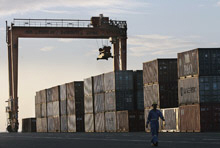
Typical street scene in Santa Ana, El Salvador. (Photo: iStock)
IMF Survey: Accurate Trade Data Key to Understanding Depth of Crisis
March 10, 2010
- Comprehensive trade data crucial for understanding severity of global crisis
- But the quality of trade price indices is not consistent across countries
- New IMF manual to improve measurement of trade price indices and terms of trade
One indicator of the severity of the recent global financial crisis was the sharp drop in global trade. The IMF has published an updated manual that would more accurately measure and analyze the depth of the recent global trade slump by setting standards for measuring price changes of exported and imported goods and services.

Container terminal in Djibouti: global trade was hit especially hard during the crisis (photo: Marco Longari/Getty Images)
Export and Import Prices
Changes in the relative prices of exported and imported goods are used for calculating changes in a country’s terms of trade—one of several indicators of economic performance. Yet, despite the importance of these data and their widespread use, the previous manual was very much out of date.
In an interview with the IMF’s Natalie Ramirez-Djumena, Mick Silver, editor of the new manual and a Senior Economist at the IMF’s Statistics Department, talks about the Export and Import Price Index Manual.
IMF Survey online: A key indicator of the depth of the recent global financial crisis was the sharp drop in world trade. How does this new manual help us measure global trade?
Silver: A proper understanding of the crisis requires high quality data. And an understanding of the extent of the drop in world trade requires an understanding of how much was due to price changes and how much was due to volume changes. The new manual provides compilers with the theory and practice to properly measure this.
IMF Survey online: How did the idea for this manual come about and why now?
Silver: Simply, the old United Nations standards were out of date—by about 30 years—as were the standards governing the compilation of consumer price indices (CPIs) and producer price indices (PPIs). The UN set up an interagency working group in 1999 to remedy this. CPI and PPI manuals were published in 2004, after which work commenced on the export and import price index (XMPI) manual.
To be relevant, accurate, and credible, the XMPI manual was developed in collaboration with national statistical agencies, international experts, and six major international organizations whose stamp it carries. We now have up-to-date international standards on the measurement of price changes of imported and exported goods at a time when such analysis may be of great importance.

Silver: “The proper measurement of terms of
trade is very important because they can have a
substantial impact on changes in a country’s
real national income.”
(photo: IMF)
IMF Survey online: Export and import price indices are mainly used to measure a country’s terms of trade. Are there other uses for these data?
Silver: The proper measurement of terms of trade is very important because they can have a substantial impact on changes in a country’s real national income. But as you mention, export and import price indices also have other uses. They help us understand the sources of inflationary pressures. They act as deflators to help estimate changes in the volume of gross domestic product by the expenditure approach. They enable the proper analysis of international competitiveness and exchange rates, provide for escalation payments in contracts, and much more.
IMF Survey online: The manual recommends using price surveys rather than customs data to calculate import and export price movements. Could you explain the difference between these two approaches?
Silver: This is an important distinction. Export and import price indices are weighted averages of price changes of commodity groups. Estimates of such price changes can be taken from customs data for invariably quite general commodity groups, such as “tennis, basketball, gym, and training shoes and the like.” The unit value of the exports from customs data would be the total value of such shoes in a month divided by the total quantity. And changes in the unit value would act as surrogates for price changes.
A problem with this measure is that such shoes are highly differentiated by brand and type. Any change in the mix of exports, say toward higher priced brands, will wrongly come out as a price increase, as inflation. A survey of exporting and importing establishments would instead select a sample of well-defined representative brands and types of shoes and monitor their prices.
IMF Survey online: Then why aren’t all countries using price surveys?
Silver: It’s because of costs. Unit value data from customs are a cheap, readily available data source. But then you get what you pay for!
The evidence shows that unit value indices may seriously misrepresent price changes. But countries may need to change to a reliance on price surveys for other reasons. For example, customs data are generally not available for trade in services, between member countries of customs unions, nor are they suitable to measure price changes of highly complex goods.
However, the techniques for undertaking price surveys of establishments are well-known by countries that compile PPIs. The manual has sound though pragmatic advice for countries that want to start compiling XMPIs based on establishment surveys.
IMF Survey online: Given these new standards, do you expect the quality of trade data to improve?
Silver: Yes, but very gradually. This has happened with CPI and PPI measurement. Changes in methodology do not come easily to national statistical offices. They require serious consideration, resources, and standards by which to do it.
The IMF’s Statistics Department works hard in promulgating new international standards in their technical assistance and training missions. The manual is about 650 pages. It is a thorough account of what should be done, why, and how to do it in practice.
Comments on this article should be sent to imfsurvey@imf.org


